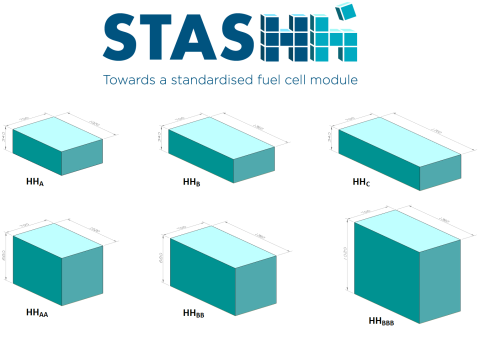Towards a standardised fuel cell module


The European StasHH consortium has hit a major milestone by setting the first ever standard for fuel cell modules for heavy-duty applications. This standard aims to globally impact the uniform development of fuel cell modules by setting clear rules regarding physical dimensions and physical and digital interfaces. The StasHH standard is thus a real game changer as it provides clear advantages for users and producers of fuel cell modules in their common goal towards reaching market competitiveness of heavy-duty fuel cell applications.
About one year after the beginning of the process, the European StasHH consortium has published their StasHH standard as a result of a consensus reached between major European fuel cell module suppliers, original equipment manufacturers and research, test, engineering and knowledge institutes. The StasHH standard comprises three parts: a definition of sizes, physical interfaces, and application programming interfaces. Inspired by the AA nomenclature for batteries, the StasHH standard applies the HH nomenclature for fuel cell modules and defines three basic sizes: A, B and C. The basic sizes can be stacked resulting in derivatives such as AA, BB and BBB. Fuel cell modules built according to these sizes allow the use in any of the heavy-duty applications within scope, including stationary, rail, waterborne, road and off-road applications.
The StasHH standard sets the width and height of the basic sizes of the fuel cell modules at 700 mm and 340 mm respectively; types differ in their length, with 1020 mm for A, 1360 mm for B and 1700 mm for C, with increments of 340 mm (the next step would be twice A). The fuel cell module components like the fuel cell stack, the air-supply system, the cooling system, the hydrogen recirculation system and the control system are included within these dimensions. Fuel cell module suppliers can determine their own power output. Inclusion of an internal DC/DC converter is optional.
The physical interconnection area of the fuel cell module, which provides the interfaces for the hydraulic, pneumatic, electrical and voltage connections for the system and the application, is also defined in the StasHH standard in terms of length and depth at the length-height side and/or width-height side of the fuel cell module. The standard defines digital interfaces as well, allowing communications among the fuel cell module, the system and the application, and convenient digital integration with existing and new applications.
Bart Biebuyck, Executive Director, Clean Hydrogen Partnership states: “Funded by the Clean Hydrogen Partnership, the project StasHH reached an important milestone in the development of standard sized fuel-cell modules in transport. By defining the first ever standard for fuel cell applications for hydrogen powered heavy-duty applications such as hydrogen trucks, StasHH will help to reduce market fragmentation, effectively lower costs and increase the competitiveness of fuel cell technology as a means to decarbonise transport.”
Now that the StasHH standard is defined, each fuel cell module supplier in the project is going to develop at least one fuel cell module according to the StasHH standard. The knowledge obtained during the development of the fuel cell modules and the subsequent testing campaign will be used to update the StasHH standard, if necessary. The consortium is committed to enabling a worldwide adoption of the StasHH standard.
The StasHH standard is publicly available on this website.
Download the press release.